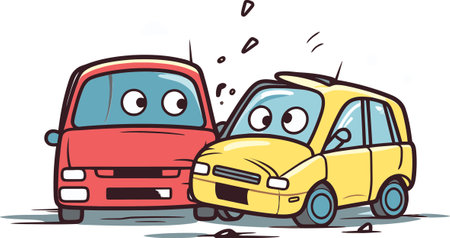Understanding Collision Coverage in the U.S.
When it comes to navigating the open roads of America, collision coverage is a time-honored pillar in any driver’s insurance arsenal. But what exactly does this coverage mean for you, and why has it become such a classic staple in American car insurance policies? Simply put, collision coverage is designed to help pay for damage to your vehicle if you’re involved in an accident—whether that’s a fender bender on Main Street or a more serious crash on the interstate. It typically covers repair or replacement costs if your car collides with another vehicle or object, regardless of who’s at fault. For generations of U.S. drivers, having collision coverage means peace of mind, knowing that even if the unexpected happens, you won’t be left footing the entire bill. As part of the broader American insurance tradition, collision coverage stands as a testament to the value placed on self-reliance and financial security while out on the road—especially when life throws you a curveball.
2. How Rental Cars Fit Into the Picture
Renting a car in America is almost a rite of passage—whether you’re cruising down Route 66 or just heading out on a weekend getaway. But when you approach that rental counter, it can feel like stepping into an old-fashioned general store: choices everywhere, everyone offering “just what you need,” and that lingering question—who’s really responsible if things go wrong? Let’s break it down. First, when you rent a car, the vehicle technically belongs to the rental company, but while it’s in your hands, you’re liable for any damage. That’s where collision coverage comes into play. Rental companies often offer their own protection plans at the counter—think of these as the modern equivalent of a shopkeeper recommending the best oil for your Model T. But before you grab whatever they’re selling, take a look at what’s actually being offered versus what you might already have through your own insurance or credit card.
| Protection Option | What It Covers | Who Provides It |
|---|---|---|
| Collision Damage Waiver (CDW) | Waives financial responsibility for damage/theft of rental car (with exceptions) | Rental Car Company |
| Your Personal Auto Policy | May extend collision/comprehensive coverage to rentals | Your Insurance Provider |
| Credit Card Coverage | Secondary or sometimes primary coverage for rental car damage | Your Credit Card Issuer |
The choices might seem overwhelming, but much like an old-timey store owner would guide you toward the best flour for your recipe, understanding these options means you won’t end up with more—or less—protection than you really need. Knowing who’s responsible and what’s on offer gives you confidence as soon as you get those keys in hand.
![]()
3. Does Your Auto Insurance Extend to Rentals?
Before you toss your suitcase in the trunk of a rental car and hit the open road, it’s crucial to know whether your trusty auto insurance policy is coming along for the ride—or staying home. In the United States, most standard auto insurance policies offer some level of coverage for rental vehicles, but there are classic “gotchas” that can catch even seasoned travelers off guard.
How Standard Policies Typically Work
If you carry collision and comprehensive coverage on your personal vehicle, those protections often extend to a rental car used for personal (not business) purposes. This means if you back into a light pole or get caught in a hailstorm, your regular policy may step up. However, the devil is in the details: coverage only matches what you have on your own car. If you have liability-only coverage, don’t expect magic protection for damages to the rental.
Common Pitfalls to Watch For
- Deductibles Still Apply: If you file a claim through your personal insurer for damage to the rental, you’ll be on the hook for your deductible—just like with your own car.
- Loss of Use Fees: Rental agencies may charge you for lost income while the car is being repaired (known as “loss of use”). Not all insurers cover this fee.
- Diminished Value: If the rental loses resale value after an accident, some companies will send you that bill. Most personal policies don’t cover this.
- Exclusions Matter: Some policies specifically exclude rentals in certain states or countries, or may not cover luxury or specialty vehicles.
The Takeaway
Before picking up those rental keys with confidence, dust off your policy documents or call your agent. Know exactly what’s covered—and what isn’t—so you’re not left footing an unexpected bill when life throws a curveball on your next American adventure.
4. Credit Card Rental Car Coverage: Fact or Fiction?
There’s a certain vintage charm to the idea that simply swiping your credit card at the rental counter unlocks a golden era of all-encompassing protection. But how much of this is nostalgia, and how much stands up to the realities of today’s roads? Let’s peel back the layers of well-polished marketing and get down to brass tacks.
The Classic Pitch: What Credit Cards Promise
Many major credit cards proudly tout rental car collision coverage as a built-in perk—no extra fees, just peace of mind as you cruise along Route 66 or navigate city streets. It sounds like an American classic: simple, straightforward, and generous. But before you put pedal to the metal, it pays to know what’s really under the hood.
Modern Realities: What’s Actually Covered?
| Coverage Feature | Typical Credit Card Protection | Common Exclusions |
|---|---|---|
| Collision Damage Waiver (CDW) | Often included if you decline rental company CDW and use your card for full payment | Does not cover liability; may exclude luxury, exotic, or certain trucks/SUVs |
| Theft Protection | Usually covered for vehicle theft | Personal items stolen from vehicle are rarely covered |
| Towing Expenses | May be included if due to covered loss | No coverage for mechanical breakdown or non-covered accidents |
| Loss of Use Fees | Sometimes covered (when rental company charges while car is out of service) | Payout depends on documentation from rental company—often disputed |
| Additional Drivers | Certain cards extend coverage if they are listed on the rental agreement | Not all cards allow this; check your policy details |
The Fine Print: Limitations and Gotchas
The devil, as always, is in the details. Most credit card protections act as secondary insurance—meaning they kick in only after your personal auto policy pays out. And there are carve-outs galore: overseas rentals may be excluded, long-term rentals often aren’t covered, and business use can void benefits entirely. The type of vehicle matters too; renting a vintage convertible for that nostalgic road trip? It might not be eligible at all.
Nostalgia Meets Nuance: Don’t Rely on Memory Lane Alone
The allure of credit card protection is steeped in classic Americana—a handshake deal, effortless convenience—but modern policies require closer inspection. Before you hit the open road, dust off those terms and conditions and make sure your “all-in-one” plastic isn’t just a relic from a simpler time. True peace of mind comes from knowing exactly where protection ends and responsibility begins.
5. When Extra Rental Insurance Makes Sense
Let’s take a moment and recall those classic American road trips—the spontaneous adventures, the detours off Route 66, or maybe that business trip out of state where you’re driving roads you’ve never seen before. In these moments, peace of mind is worth its weight in gold. So, when does it truly make sense to consider extra rental insurance from the agency? First, if your personal auto policy doesn’t cover rentals or you only carry minimal coverage, you might want to think twice before declining. Likewise, if you’re traveling for business and your company’s insurance doesn’t extend to your rental, opting for the agency’s collision damage waiver (CDW) can be a wise move. Then there are situations where you simply crave that all-American reassurance—no worries about deductibles or haggling with your insurer after an accident. Maybe you’re driving a rental in unfamiliar territory, facing unpredictable weather or city traffic that feels like rush hour in Chicago every day. In these scenarios, paying a little extra at the counter buys you a safety net and keeps your trip stress-free. It’s all about balancing your budget with the value of true peace of mind. Remember, sometimes a few extra dollars spent upfront can save you from headaches—and wallet aches—down the road.
6. Tips for Feeling Fully Protected Out on the Open Road
There’s something timeless about hitting the open road—windows down, music up, and the promise of adventure ahead. But before you let nostalgia take the wheel, it pays to make sure your collision coverage really has your back when you’re behind the wheel of a rental car. Here’s a hand-picked collection of practical, all-American tips to help you cruise with peace of mind.
Double-Check Your Coverage Before You Go
Before you even pick up the keys at the rental counter, dust off that insurance policy and review the details. Does your auto insurance extend to rentals? Is collision coverage included, or just liability? If you’re unsure, call your agent—old-fashioned customer service still works wonders.
Consider Standalone Rental Insurance
If your own policy comes up short, consider purchasing a Collision Damage Waiver (CDW) from the rental company. It’s an extra cost, but think of it as a classic safety net—like carrying a spare tire in your trunk.
Don’t Rely Solely on Credit Cards
Many credit cards offer some rental car protection, but don’t assume it covers everything. Check those terms and conditions closely—nothing says “retro road trip” like reading the fine print over a cup of diner coffee.
Inspect Your Ride Before Hitting the Highway
Take a walk around your rental car and note any dings, scratches, or quirks before driving off. Snap photos for your records—the kind of attention to detail that would make your granddad proud.
Keep Those Documents Handy
Whether it’s your insurance card or rental agreement, keep copies handy in the glovebox or on your phone. Should anything happen out on Route 66 or Main Street USA, you’ll be ready to handle it like a seasoned road warrior.
Drive Safe and Savor Every Mile
The best way to protect yourself? Drive cautiously and enjoy every moment. When you’re fully protected, you can let nostalgia lead the way—just like families did on summer vacations decades ago. So buckle up, trust your coverage, and savor every mile of America’s highways with confidence.


